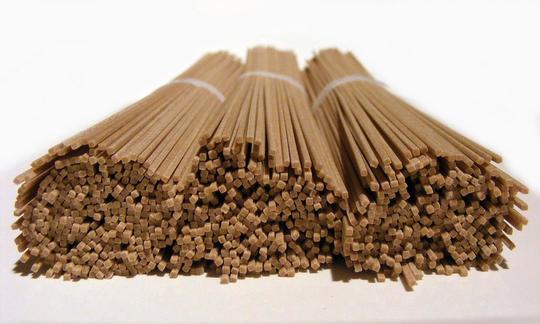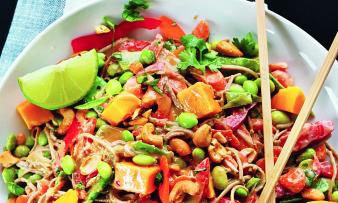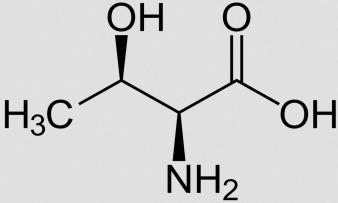Table of contents
Soba noodles have their origins in Japanese cuisine and consist (partly) of buckwheat flour. Rarely available in organic quality.
Use in the kitchen
What are soba noodles? Soba are thin, brown-gray noodles that are traditionally made from buckwheat . They taste slightly nutty and have a strong flavor of their own. In Japanese cuisine, soba noodles are often served in a broth (noodle soup) with various side dishes. The broth is warm or cold depending on the season. Soba noodles that are served with a separate soy sauce-based sauce and nori (zaru soba) are also popular. Sometimes a little of the cooking water is mixed into the sauce.
Buckwheat noodles (preferably organic) can also be used as a substitute for whole-grain spaghetti or whole-grain macaroni , and served with tomato sauce or pesto. They also taste delicious with peas, pistachios and sprouts . Cooked and cooled soba are also suitable for salads, for example with cashew dressing or with a satay sauce and sugar snap peas .
Soba (Japanese: 蕎麦 or そば) means buckwheat. The word "soba" is also sometimes used for noodle dishes that contain wheat noodles, for example chūka soba (another name for ramen), yakisoba (fried noodles) and Okinawa soba (a noodle soup with udon-like noodles). Other well-known Asian noodles are ramen, udon, shirataki noodles (konjac) , rice noodles and rice noodles ('spaghettini') .
Since raw buckwheat has no lectins, it is ideal for raw food. However, we could not find any raw or even raw quality soba noodles. It is possible to make your own from raw buckwheat flour. This gives you raw quality soba that you could eat "raw". However, this is not usually done; instead, the noodles are cooked, which is why they are no longer raw. For raw noodles, we recommend using zucchini spaghetti .
yourself
Soba is also easy to make . To do this, make a dough from 100 g buckwheat flour, 50 ml water and a little salt. Wrap the firm, relatively dry dough in cling film and leave to rest for 10 minutes. Then carefully roll out the dough and then use a knife to cut the noodles to the desired thickness.
The soba noodles can then be left to dry or used straight away. To do this, bring 1 liter of water to the boil and carefully add the noodles. After 5-10 minutes, the noodles are usually cooked (depending on the thickness of the noodles). Pour off the cooking water, rinse the soba noodles with cold water and eat straight away. You can also store cooked noodles in an airtight container in the refrigerator for 1-2 days.
Vegan recipe for miso soup with tofu and sobanu noodles
Ingredients (for 4 people): 250 g soba noodles, 2 spring onions , 1 tbsp dried wakame , 200 g tofu, 1 l water , 1 sheet of kombu seaweed , 2 shiitaki mushrooms , 2-3 tbsp miso . As needed: low-salt soy sauce (Genen Shoyu) , mirin (rice wine).
Preparation: Cook the soba noodles according to the instructions on the packet until al dente, drain the water, rinse the noodles in cold water and drain well. Wash the spring onions and cut into fine rings. Cut the tofu into cubes of about 2 cm. Rinse the wakame in cold water, pour lukewarm water over it in a bowl so that everything is well covered with water. Leave to soak for 10-15 minutes and then pour through a sieve and squeeze out the remaining liquid well with your hands. Wash the shiitaki mushrooms and cut into large pieces.
For the broth, heat cold water, kombu and shiitake at a medium heat to 60°C and cover and leave to simmer for 30 minutes. Then remove the kombu. Add spring onions, wakame, tofu and cooked soba noodles to the broth and heat, but do not boil. Remove a little of the cooking liquid (with a soup spoon) and dissolve the miso paste in it. Then add the dissolved miso to the soup, stir and serve the soup immediately. Season with soy sauce and mirin if necessary.
Vegan recipes with soba noodles (soba) can be found under the note: " Recipes that have the most of this ingredient ".
| Not only vegans or vegetarians should read this: Vegans often eat unhealthily. Avoidable nutritional mistakes . |
Purchasing - Storage
Soba noodles can be purchased at major retailers such as Coop , Migros , Spar , Rewe , Edeka and Billa . Denner , Volg , Aldi , Lidl and Hofer as well as organic supermarkets such as Denn's Biomarkt and Alnatura do not currently have soba noodles in their standard range.
Soba is available in a variety of varieties and qualities. Both inexpensive and high-quality soba noodles can contain wheat flour. Soba noodles made from 100% buckwheat can be bought in Asian shops, health food stores and online. They are also easy to make yourself.
Note that some packaged noodles are labeled "soba" even though they contain little or no buckwheat flour. Often they also contain small bags of seasoning and sauce. These are mostly instant fried noodles (yakisoba).
The availability of soba noodles varies depending on the size of the store, catchment area, etc. Our recorded food prices for the DA-CH countries can be found above under the ingredient image - and by clicking on them you can see their development at different suppliers.
Storage tips
Soba noodles should be stored in an airtight container in a dry, cool place protected from the sun.
Ingredients - Nutritional values - Calories
100 g of soba noodles (organic?) have an energy content of 336 kcal. The largest portion is made up of carbohydrates at 75 g/100g. Proteins are also plentiful at 14 g/100g. They are almost fat-free (0.71 g/100g). The high salt content should not be underestimated. This can make up 508 mg per 100g, which corresponds to 21.2% of the daily requirement. 1
The calorie content of soba noodles is comparable to whole wheat spaghetti (352 kcal) and rice noodles (364 kcal). Shirataki noodles , on the other hand, contain only 10 kcal/100g.
Soba noodles contain large amounts of essential amino acids. The most important amino acid is tryptophan at 0.20 g/100g, which corresponds to 82.0% of the daily requirement. Dried porcini mushrooms (1.5 g/100g), soy granules (0.62 g) and raw soybeans (0.59 g) contain particularly high levels of tryptophan. Threonine is the second most abundant essential amino acid at 0.50 g. The content covers 54.0% of the daily requirement. Soy granules and soybeans are also rich in threonine. Lupine flour and lupine meal (1.4 g and 1.3 g/100g respectively) as well as hemp seeds (1.3 g/100g) also contain large amounts of the amino acid threonine. 1
Manganese is present in soba at 1.3 mg per 100 g of noodles, which covers 65% of the daily requirement. In comparison, the manganese content in whole-grain spaghetti is 3.0 mg/100g and in rice noodles 0.50 mg/100g. 1
The complete ingredients of soba noodles (soba), the coverage of the daily requirement and comparison values with other ingredients can be found in our nutrient tables. In the article Nutrients explained you will get a detailed insight into the topic.
Health effects
Does soba have gluten? Soba noodles are considered gluten-free because they are made from buckwheat. 2 However, many commercially available soba noodles contain varying amounts of wheat flour and are therefore not gluten-free (more on this under Industrial production). Anyone who suffers from gluten intolerance or celiac disease (sprue, gluten-sensitive enteropathy) should therefore always read the ingredients list carefully and look for the gluten-free symbol, which only licensed products are allowed to carry. There are efforts to produce gluten-free buckwheat noodles. Corn starch or potato starch is used to increase the suppleness of the noodles despite not using wheat flour. 6
Are soba noodles healthy? Soba is made from buckwheat, which is considered a healthy pseudo-cereal. The polyphenols it contains (rutin and quercetin) have shown strong antioxidant activity in in vivo studies. Consumption of buckwheat or products enriched with buckwheat also have anti-inflammatory and anti-cancer effects and can help with hypercholesterolemia (high cholesterol) and hypoglycemia (low blood sugar). 7
Consumption of buckwheat reduces risk markers for cardiovascular disease, such as blood sugar levels, total cholesterol and triglycerides. 8,9 A study with mice also found an increase in glucose tolerance. 8 Buckwheat contains D-chiro-inositol and fagopyritol, among others, which have insulin-like activity and improve insulin resistance. Regular consumption of buckwheat and Tatar buckwheat could therefore be useful in the treatment of diabetes. 8
It remains to be seen whether increased buckwheat intake has significant effects on some risk markers for cardiovascular disease, such as body weight and LDL cholesterol. There is growing evidence that the reduction in some risk markers associated with cardiovascular disease may be due to polyphenol (phytochemical), soluble fiber, protein, rutin, quercetin and other components in buckwheat. However, it is not yet fully understood which bioactive compounds are responsible for the underlying effects. Further research, particularly large, high-powered long-term human studies, is needed to better understand and promote the role that buckwheat may play in cardiovascular health. 9
Dangers - Intolerances - Side effects
Allergic reactions to buckwheat are known. The allergens trigger an IgE-mediated immediate hypersensitivity reaction of type I. Possible symptoms are asthma, allergic rhinitis, urticaria (hives, nettle rash), angioedema (swelling under the skin, usually on the face). There is evidence of a cross allergy between buckwheat and rice. 4 In addition to consumption, inhaling buckwheat flour and chaff can also cause allergic reactions.
Initial studies show that fermenting buckwheat with the noble mold ( Rhizopus oligosporus ) before milling reduced the allergic potential. Rhizopus oligosporus is used in Asia to make tempeh . The fermented buckwheat also had higher amounts of amino acids, including isoleucine, leucine, lysine, valine, glycine, histidine, tyrosine and γ-aminobutyric acid (GABA). 5
Ecological footprint - animal welfare
Despite extensive research, we have not yet found any significant information on the ecological footprint of soba noodles. However, there is data on buckwheat , which is used to make soba noodles.
Worldwide occurrence - cultivation
Soba noodles originate from Japan. However, buckwheat noodles are popular throughout the East Asian region (China, Korea, Japan). 3
For this purpose, grains of common buckwheat ( Fagopyrum esculentum ) or Tatar buckwheat or false buckwheat ( Fagopyrum tataricum ) are used.
Industrial production
The process of traditional soba noodle making consists of three main steps: mixing the moistened buckwheat flour, rolling the dough, and cutting the noodles. Typically, buckwheat flour is mixed with other flours (e.g. wheat), salt (1–2% by weight of flour), and water, and the mixture is kneaded into a dough using a mixer. Mixing is generally followed by resting the dough. The dough is then rolled using a rolling machine. The purpose of rolling is to obtain a smooth, homogeneous sheet of dough with the desired thickness. The sheets of dough are then cut into noodles. To prepare dried or semi-dried buckwheat noodles, the fresh noodles are dried using a dehydrator. 3
Making pure buckwheat noodles is difficult because there is no gluten to form a cohesive dough. The dough appears dry and brittle and is difficult to work with. For this reason, the dough is often "optimized" by adding wheat flour, gluten, emulsifiers and hydrocolloids. From a nutritional point of view, however, a high buckwheat content without the addition of any additives is more desirable. 2
In Japan, handmade soba noodles are made from a mix of 7-8 parts buckwheat flour and 2-3 parts wheat flour. Machine-made soba contains a higher proportion of wheat flour (40-80%) because the dough needs to have a higher binding power. 3 According to the standard for dried buckwheat noodles within the framework of the Japan Agricultural Standards for dried noodles, a minimum proportion of 40% buckwheat is considered standard quality and a minimum proportion of 50% buckwheat is considered high quality. 2
Further information
Soba is made from buckwheat, whereby this usually means true buckwheat ( Fagopyrum esculentum ). This comes from the genus buckwheat ( Fagopyrum ) and belongs to the knotweed family (Polygonaceae). Buckwheat is a pseudocereal, as it is not a monocotyledonous plant, but a dicotyledonous one.
In addition to buckwheat, a member of the knotweed family, the amaranth ( Amaranthus ) and quinoa ( Chenopodium quinoa ) are important for nutrition. Closely related and used in a similar way is kañiwa or cañihua ( Chenopodium pallidicaule ). Also known as pseudocereals are the seeds of the Mexican chia ( Salvia hispanica ) from the mint family.
Alternative names
In German, soba is sometimes also called buckwheat noodles. The English name is soba, soba noodles or buckwheat noodles.









Comments